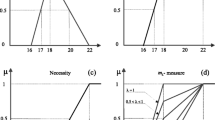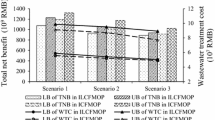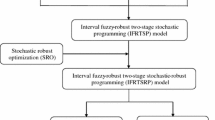Abstract
In this study, an interval-fuzzy two-stage chance-constrained integer programming (IFTCIP) method is developed for supporting environmental management under uncertainty. The IFTCIP improves upon the existing interval, fuzzy, and two-stage programming approaches by allowing uncertainties expressed as probability distributions, fuzzy sets, and discrete intervals to be directly incorporated within a general mixed integer linear programming framework. It has advantages in uncertainty reflection, policy investigation, risk assessment, and capacity-expansion analysis in comparison to the other optimization methods. Moreover, it can help examine the risk of violating system constraints and the associated consequences. The developed method is applied to the planning for facility expansion and waste-flow allocation within a municipal solid waste management system. Violations of capacity constraints are allowed under a range of significance levels, which reflects tradeoffs between the system cost and the constraint-violation risk. The results indicate that reasonable solutions for both binary and continuous variables have been generated under different risk levels. They are useful for generating desired decision alternatives with minimized system cost and constraint-violation risk under various environmental, economic, and system-reliability conditions. Generally, willingness to take a higher risk of constraint violation will guarantee a lower system cost; a strong desire to acquire a lower risk will run into a higher system cost.






Similar content being viewed by others
References
Ahmed, S. (2000). Strategic Planning under Uncertainty: Stochastic Integer Programming Approaches, Ph.D. Thesis. Urbana, IL: University of Illinois.
Ahmed, S., Tawarmalani, M., & Sahinidis, N. V. (2004). A finite branch-and-bound algorithm for two-stage stochastic integer programs. Mathematic Program Search A, 100, 355–377.
Albornoz, V. M., Benario, P., & Rojas, M. E. (2004). A two-stage stochastic integer programming model for a thermal power system expansion. International Transactions in Operational Research, 11, 243–257.
Baetz, B. W. (1988). Capacity planning for production facilities and alternative facilities with consumable capacity: application to waste management systems, Ph.D. Dissertation. USA: Duke University.
Baetz, B. W. (1990a). Capacity planning for waste management systems. Civil Engineering Systems, 7, 229–235.
Baetz, B. W. (1990b). Optimization/simulation modeling for waste management capacity planning. Journal of Urban Planning and Development (ASCE), 116, 59–79.
Baetz, B. W., Pas, E. I., & Neebe, A. W. (1989). Trash management: sizing and timing decisions for incineration and landfill facilities. Interfaces, 19(6), 52–61.
Bean, J. C., Higle, J. L., & Smith, R. L. (1992). Capacity expansion under stochastic demands. Operations Research, 40, 210–216.
Berman, O., & Ganz, Z. (1994). The capacity expansion problem in the service industry. Computers & Operations Research, 21, 557–572.
Berman, O., Ganz, Z., & Wagner, J. M. (1994). A stochastic optimization model for planning capacity expansion in a service industry under uncertain demand. Naval Research Logistics, 41, 545–564.
Birge, J. R., & Louveaux, F. V. (1997). Introduction to stochastic programming. New York, NY: Springer.
CarØe, C. C., & Tind, J. (1998). L-shaped decomposition of two-stage stochastic programs with integer recourse. Mathematical Programming, 83, 451–464.
Chang, N. -B., Chen, Y. L., & Wang, S. F. (1997). A fuzzy interval multiobjective mixed integer programming approach for the optimal planning of solid waste management systems. Fuzzy Sets and Systems, 89, 35–59.
Chang, N. -B., & Wang, S. F. (1996). Solid waste management system analysis by multi-objective mixed integer programming model. Journal of Environmental Management, 48, 17–43.
Chang, N.-B., & Wei, Y. L. (2000). Siting recycling drop-off stations in urban area by genetic algorithm-based fuzzy multiobjective nonlinear integer programming modeling. Fuzzy Sets and System, 114, 133–149.
Clayton, K. C. (1976). A planning model for regional solid waste management systems. Ph. D. Dissertation, Purdue University.
Edirisinghe, N. C. P., Patterson, E. I., & Saadouli, N. (2000). Capacity planning model for a multipurpose water reservoir with target-priority operation. Annals of Operations Research, 100, 273–303.
Ellis, J. H. (1991). Stochastic programs for identifying critical structural collapse mechanisms. Applied Mathematical Modelling, 15, 367–379.
Ellis, J. H., McBean, E. A., & Farquhar, G. J. (1985). Chance-constrained stochastic linear programming model for acid rain abatement-I. Complete and noncolinearity. Atmospheric Environment, 19, 925–937.
Ellis, J. H., McBean, E. A., & Farquhar, G. J. (1986). Chance-constrained stochastic linear programming model for acid rain abatement-II. Limited colinearity. Atmospheric Environmrnt, 20, 501–511.
Hasit, Y., & Warner, D. B. (1981). Regional solid waste planning with WRAP. Journal of Environmental Engineering Division (ASCE), 107, 511–526.
Huang, G. H. (1998). A hybrid inexact-stochastic water management model. European Journal of Operational Research, 107, 137–158.
Huang, B. W., Baetz, G. H., & Patry, G. G. (1994). Capacity planning for municipal solid waste management systems under uncertainty – A grey fuzzy dynamic programming (GFDP) approach. Journal of Urban Planning and Development, 120(3), 132–156.
Huang, G. H., Baetz, B. W., & Patry, G. G. (1995a). Grey integer programming: An application to waste management planning under uncertainty. European Journal of Operational Research, 83, 594–620.
Huang, G. H., Baetz, B. W., & Patry, G. G. (1995b). Grey fuzzy integer programming: an application to regional waste management planning under uncertainty. Socio-economic Planning Science, 29, 17–38.
Huang, G. H., Baetz, B. W., Patry, G. G., & Terluk, V. (1997). Capacity planning for an integrated waste management system under uncertainty: a north American case study. Waste Management & Research, 15, 523–546.
Huang, G. H., Sae-Lim, N., Liu, L., & Chen, Z. (2001). An interval-parameter fuzzy-stochastic programming approach for municipal solid waste management and planning. Environmental Modeling and Assessment, 6, 271–283.
Ignizio, J. P., & Daniels, S. C. (1983). Fuzzy multicriteria integer programming via fuzzy generalized networks. Fuzzy Sets and Systems, 10, 261–270.
Jenkins, L. (1980). The Ontario waste management systems model. Canada: Ontario Ministry of Environment.
Jenkins, L. (1982). Developing a solid waste management model for Toronto. INFOR, 20, 237–247.
Kuhner, J., & Harrington, J. J. (1975). Mathematical models for developing regional solid waste management policies. Engineering Optimization, 1, 237–256.
Li, Y. P., Huang, G. H., & Baetz, B. W. (2006). Municipal solid waste management under uncertainty – an interval-parameter two-stage chance-constrained mixed integer linear programming method. Environmental Engineering Science, 23(5), 761–779.
Li, Y. P., Huang, G. H., & Nie, S. L. (2007). Mixed interval-fuzzy tow-stage integer programming and its application to flood-diversion planning. Engineering Optimization, 39(2), 163–183.
Li, Y. P., Huang, G. H., Nie, S. L., Nie, X. H., & Maqsood, I. (2006). An interval-parameter two-stage stochastic integer programming model for environmental systems planning under uncertainty. Engineering Optimization, 38(4), 461–483.
Liu, L., Huang, G. H., Liu, Y., & Fuller, G. A. (2003). A fuzzy-stochastic robust programming model for regional air quality management under uncertainty. Engineering Optimization, 35(2), 177–199.
Loucks, D. P., Stedinger, J. R., & Haith, D. A. (1981). Water Resource Systems Planning and Analysis. Englewood Cliffs, NJ: Prentice–Hall.
Morgan, D. R., Eheart, J. W., & Valocchi, A. J. (1993). Aquifer remediation design under uncertainty using a new chance constrained programming technique. Water Resources Research, 29, 551–568.
ReVelle, C. (1999). Optimizing reservoir resources. New York: Wiley.
Swaminathan, J. M. (2000). Tool capacity planning for semiconductor fabrication facilities under demand uncertainty. European Journal of Operational Research, 120, 545–558.
Teghem, J., & Kunsch, P. (1986a). Complete characterization of efficient solutions for multiobjective integer linear programming. Asia-Pacific Journal of Operation Research, 3, 95–108.
Teghem, J., & Kunsch, P. (1986b). Interactive method for multiobjective integer linear programming. In A. Fandel (Ed.) Large scale modelling and interactive decision analysis (pp. 75–87). Berlin: Springer.
USEPA (1998). United States Environmental Protection Agency. Washington.
Yeomans, J. S., & Huang, G. H. (2003). An evolutionary grey, hop, skip, and jump approach: Generating alternative policies for the expansion of waste management. Journal of Environmental Informatics, 1, 37–51.
Zimmermann, H. J., & Pollatschek, M. A. (1984). Fuzzy 0–1 linear programs. In H. -J. Zimmermann, L. A. Zadeh, & B. R. Gaines (Eds.) Fuzzy sets and decision analysis (pp. 133–146). Amsterdam: North-Holland.
Zimmermann, H. J. (1985). Fuzzy set theory and its applications. Kluwer-Nijhoff: Boston.
Acknowledgments
This research was supported by the Major State Basic Research Development Program (2005CB724200, 2006CB403303, and 2006CB403307), and the Natural Science Foundation (50675074, 50775081, and 2006AA09Z238) of China, and the Natural Science and Engineering Research Council of Canada. The authors are grateful to the editors and the anonymous reviewers for their insightful comments and suggestions.
Author information
Authors and Affiliations
Corresponding author
Appendices
Appendix A
1.1 Solution Method
A two-step solution method is proposed for solving the developed IFTCIP model. Then, model 5 can be transformed into two deterministic submodels, which correspond to the lower and upper bounds of the objective function value, respectively. Interval solutions, with varying levels of constraint-violation risk, can then be obtained by solving the two submodels sequentially. When the objective is to be minimized, the submodel with λ + (corresponding to f −) can be firstly formulated and solved (assume that B ± > 0, and f ± > 0) as:
subject to:
where \(\underline w _{\,rh}^ - \) is the lower boundary of lower interval number; \(\overline w _{rh}^{\, - } \) is the upper boundary of lower interval number; \(\underline w _{\,rh}^ + \) is the lower boundary of upper interval number; \(\overline w _{rh}^{\, + } \) is the upper boundary of upper interval number. Assume that there is no intersection between the two bounds of interval numbers (i.e.,\(\left[ {\underline w _{\,rh}^ + ,{\text{ }}\overline w _{rh}^{\, + } } \right]\) and \(\left[ {\underline w _{rh}^ - ,{\text{ }}\overline w _{rh}^{\, - } } \right]\) ).
In submodels 8a, 8b, 8c, 8d, 8e, 8f, 8g, 8h, 8i, 8j, and 8k, \(x_j^ - \left( {j{\text{ }} = {\text{ }}1,{\text{ }}2, \ldots ,{\text{ }}k_1 } \right)\) are interval variables with positive coefficients in the objective function; \(x_j^ + \left( {j = k_1 + 1,{\text{ }}k_1 {\text{ }} + {\text{ }}2, \ldots ,{\text{ }}n_1 } \right)\) are interval variables with negative coefficients; \(y_{jh}^ - \) (h = 1, 2,…, v and j = 1, 2,…, k 2) are random variables with positive coefficients in the objective function;\( \,y_{jh}^ + \) (h = 1, 2,..., v and j = k 2 + 1, k 2 + 2, ...,n 2) are random variables with negative coefficients. Solutions of \(x_{j\,{\text{opt}}}^ - \left( {j = 1,{\text{ }}2, \ldots ,{\text{ }}k_1 } \right)\), \(x_{j\,{\text{opt}}}^ + \left( {j = {\text{ }}k_1 {\text{ }} + 1,{\text{ }}k_1 + 2, \ldots ,n_1 } \right)\),\(y_{jh\,{\text{opt}}}^ - \left( {j = 1,{\text{ }}2, \ldots ,{\text{ }}k_2 } \right)\), \(y_{jh\,{\text{opt}}}^ + \left( {j{\text{ }} = {\text{ }}k_2 + {\text{ }}1,{\text{ }}k_2 + 2, \ldots ,{\text{ }}n_2 } \right)\), and \(\lambda _{{\text{opt}}}^ + \) can be obtained through solving submodels 8a, 8b, 8c, 8d, 8e, 8f, 8g, 8h, 8i, 8j, and 8k. Based on the above solutions, the second submodel for λ − (corresponding to f +) can be formulated as follows:
subject to:
Solutions of \(x_{j\,{\text{opt}}}^ + \left( {j = 1,{\text{ }}2, \ldots ,{\text{ }}k_1 } \right)\), \(x_{j\,{\text{opt}}}^ - (j = k_1 + 1,{\text{ }}k_1 + 2, \ldots ,{\text{ }}n_1 )\), \(y_{jh\,{\text{opt}}}^ + (j = 1,{\text{ }}2, \ldots ,{\text{ }}k_2 )\), \(y_{jh\,{\text{opt}}}^ - \left( {j = k_2 + 1,{\text{ }}k_2 {\text{ }} + {\text{ }}2, \ldots ,{\text{ }}n_2 } \right)\), and \(\lambda _{{\text{opt}}}^ - \)can be obtained through submodels 9a, 9b, 9c, 9d, 9e, 9f, 9g, 9h, 9i, 9j, and 9k. The general solution for the IFTCIP model can thus be expressed as follows:
Then, the expected objective function value can be calculated as:
Thus, we have \(f_{{\text{opt}}}^ \pm = \left[ {f_{{\text{opt}}}^ - ,{\text{ }}f_{{\text{opt}}}^ + } \right]\).
Appendix B
1.1 List of symbols
i | type of waste management facility, and I = 2; where i = 1 for landfill, and i = 2 for incinerator |
j | name of city, j = 1, 2 |
k | planning period, k = 1, 2, 3 |
L k | length of period k (day), and each period with 5 years |
h | level of waste generation rate in city j, h = 1, 2,…, H |
m | name of expansion option for waste management facilities, m = 1, 2,…, M |
\({\text{DG}}_{ik}^ \pm \) | regulated diversion rate of waste flow to facility i in period k (%), i = 2 |
\({\text{DP}}_{ik}^ \pm \) | operating cost of facility i for excess waste flow during period k (the second-stage cost parameter) ($/ton), where \({\text{DP}}_{ik}^ \pm \geqslant {\text{OP}}_{ik}^ \pm \) |
\({\text{DR}}_{ijk}^ \pm \) | transportation cost for excess waste flow from city j to facility i during period k (the second-stage cost parameter) ($/ton), where \({\text{DR}}_{ijk}^ \pm \geqslant {\text{TR}}_{ijk}^ \pm \) |
\({\text{DT}}_{ik}^ \pm \) | transportation cost of excess waste residue from waste disposal facility i to the landfill during period k (the second-stage cost parameter) ($/ton), where \({\text{DT}}_{ik}^ \pm \geqslant {\text{FT}}_{ik}^ \pm \) and i = 2 |
\({\text{FE}}_i^ \pm \) | residue flow rate from facility i to the landfill (% of incoming mass to facility i), i = 2 |
\({\text{FLC}}_k^ \pm \) | capital cost of landfill expansion in period k ($/ton) |
\({\text{FT}}_{ik}^ \pm \) | transportation cost for allowable residue flow from facility i to the landfill during period k ($/ton), i = 2 |
\({\text{FTC}}_{imk}^ \pm \) | capital cost of expanding facility i by option m in period k ($/ton), i = 2 |
\({\text{L}}\underline {\text{C}} ^{q_1 } \) | lower bound of existing landfill capacity corresponding to significance level (q 1) (ton) |
\({\text{L}}\overline {\text{C}} ^{q_1 } \) | upper-bound existing landfill capacity corresponding to significance level (q 1) (ton) |
\(\Delta {\text{LC}}_{mk}^ \pm \) | level of capacity expansion for the landfill with option m in period k (ton) |
\(M_{ijkh}^ \pm \) | amount by which the allowable waste flow level (X ijk ) is exceeded when the waste-generation rate is w jkh with probability p jh (ton/day) |
\({\text{OP}}_{ik}^ \pm \) | operating cost of facility i for allowable waste flow during period k ($/ton) |
\(p_{jh} \) | probability of waste-generation rate (w jkh ) in city j with generation level h (%) |
qi | probability of violating the existing capacity of facility i (%) |
\({\text{RE}}_{ik}^ \pm \) | revenue from allowable waste flow treated by facility i during period k (the first-stage cost parameter) ($/ton), i = 2 |
\({\text{RM}}_{ik}^ \pm \) | Revenue from excess flow treated by facility i during period k (the second-stage cost parameter) ($/ton), i = 2 |
\(T_{ijkh}^ \pm \) | amount of increased allowance from city j to facility i under waste-generation rate h in period k (the second-stage decision variable) (ton/day); |
\({\text{T}}\underline {\text{C}} _i^{q_i } \) | lower-bound existing capacity of facility i under significance level (q i ) (ton/day), i = 2 |
\({\text{T}}\overline {\text{C}} _i^{q_i } \) | upper-bound existing capacity of facility i under significance level (q i ) (ton/day), i = 2 |
\(\Delta {\text{TC}}_{imk}^ \pm \) | level of expansion option m for facility i at the start of period k (ton/day), and i = 2 |
\({\text{TR}}_{ijk}^ \pm \) | transportation cost for allowable waste flow from city j to facility i during period k (the first-stage cost parameter) ($/ton) |
η1 | quota of incremental value for allowable flow to the landfill (ton/day) |
\(\underset{\raise0.3em\hbox{$\smash{\scriptscriptstyle\thicksim}$}}{W} _{jkh}^ - \) | lower-bound waste generation rate in city j with probability level h in period k (ton/day) |
\(\underset{\raise0.3em\hbox{$\smash{\scriptscriptstyle\thicksim}$}}{W} _{jkh}^ + \) | upper-bound waste generation rate in city j with probability level h in period k (ton/day) |
\(X_{ijk}^ \pm \) | allowable waste flow from city j to facility i in period k (the first-stage variable) (ton/day) |
\(Y_{mk}^ \pm \) | binary decision variable for landfill expansion with option m at the start of period k |
\(Z_{imk}^ \pm \) | binary decision variable for facility i with expansion option m at the start of period k, i = 2 |
Rights and permissions
About this article
Cite this article
Li, Y.P., Huang, G.H., Yang, Z.F. et al. IFTCIP: An Integrated Optimization Model for Environmental Management under Uncertainty. Environ Model Assess 14, 315–332 (2009). https://doi.org/10.1007/s10666-007-9128-0
Received:
Accepted:
Published:
Issue Date:
DOI: https://doi.org/10.1007/s10666-007-9128-0




